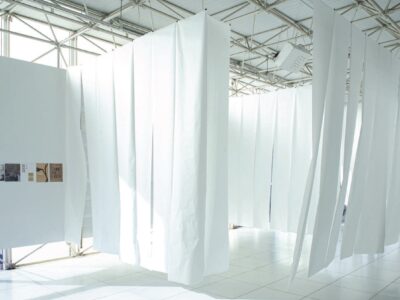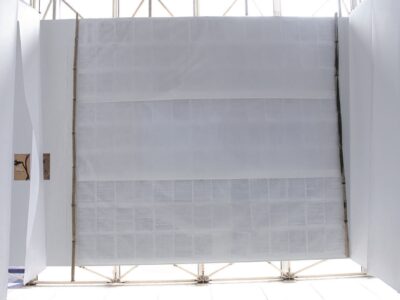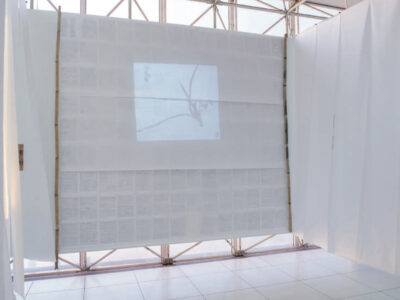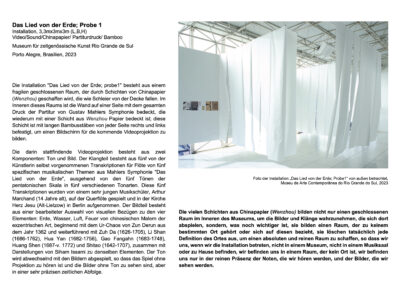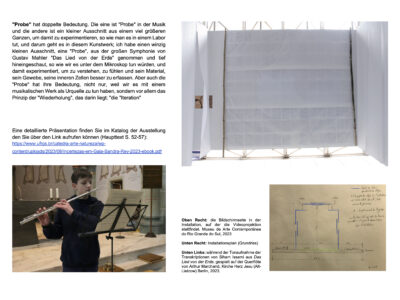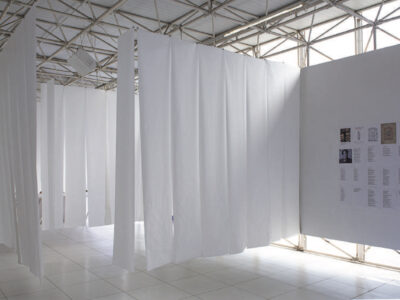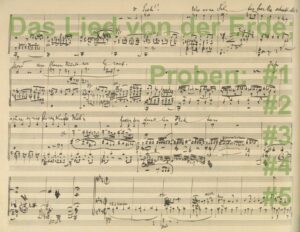
General Presentation
The word “Probe” in German has a double meaning. One which is “rehearsal” in music and another one that means a small bit taken from a much larger whole in order to experiment the way one does in a laboratory, and that what this work of art is about; to take tiny tiny bites, “Proben”, from the large symphony of Gustav Mahler “das Lied von der Erde” and look deeply into each one of them as we would do under a microscope. And so experiment with each one in order to understand, to feel and get a better grasp of its material, its tissues, its inner cells. But the “rehearsal” meaning in it has also its importance not only because we are dealing with a musical work as primal source, but foremost the principle of “repetition”, that is within, “the recurrence” and “iteration”.
There are five “Proben” in all, and thus five installations, following the characteristic of the pentatonic music scale, an eastern music scale, which has five note and which Mahler used here denoting the eastern orientated symphony.
Each installation is meant to be created for each continent. The first started in Brazil and was built at the Museum of Contemporary Art Rio Grande de Sul in Porto Alegre in 2023.
Das Lied von der Erde; Probe I
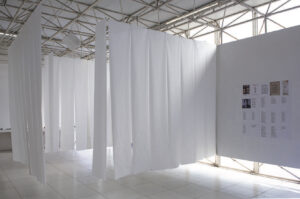
Description
The installation “Das Lied von der Erde; probe1” (Earth’s song, Attempt #1) consists of a fragile closed space created through layers of Chinese paper falling from the ceiling like veils. Inside this space in one side, the wall is covered by the entire print of the score of Gustav Mahler’s symphony, which is covered in its turn with a layer of Chinese paper; this layer is fixed by long Bambu sticks from each side right and left, in order to form a screen for the video projection to come.
The video projection taking place in it has two components: sound and images. The sound part consists of five transcriptions for flute by the artist herself of five specifics musical themes from Mahler’s Symphony “Das Lied von der Erde”, starting with the five notes of the pentatonic scale in five different tonalities (example 1 here below). These five transcriptions were played on Flute by a very young music pupil, Arthur Marchand (14 years old) and were recorded in the Church Herz Jesu (Alt-Lietzow) in Berlin. The image part consists of a selection of visual references to the four elements: Earth, Water, Air, Fire from the Chinese painters of the eccentric way starting with the primordial Chaos of Zun Derun from 1362 and continuing with, Zuh Da (1626-1705) , Li Shan (1686-1762), Hua Yan (1682-1756), Gao Fangahn (1683-1748), Huang Shen (1687-v. 1772) and Shitao (1642-1707), a long with representations by Siham Issami of those same Elements (example 2 below: water). The sound is played alternatively with the images, so that the playing is heard without projection and the images are seen without sound, but in very precisely timed sequel.
Pentatonic Scale in 5 tonalities played by Arthur Marchand, transverse Flute, Church Herz Jesu (Alt-Lietzow, Berlin) 02.2023
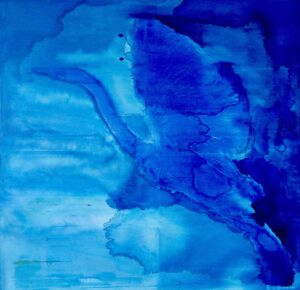
Water, Chinese ink on Canvas, 150cmx150cm
A more detailed presentation is to be found in the link bellow to the catalogue as e-book:
Supplementary notes:
1- Space and sound / the non-place
when we listen to a piece of music we are inevitably somewhere, as we are inevitably bound to be somewhere wherever we are and whatever we do. But in music the Place is even more determining than with anything else. The conscience we have of music varies from place to place; the reception of music is different according to the place where we are, the degree of attentiveness, the degree of affect… etc.
when we are in a museum we have a certain attitude, a mental preparation to what we are going to do there and thus we behave accordingly; what we perceive is defined in some way by where it is perceived.
The multiple layers of Chinese paper do not only build a closed space inside the museum space to perceive the images and sound that are happening there, but more importantly build a space that doesn’t belong or relate to any specific place, it actually erase any definition the Place have in order to create an absolute and pure Space so that when we enter the installation, we are not in a museum, we are not in music hall, we are not at home or in a car, we are not in any defined Place, we are in a space that is a non-Place, we are only in the pure presence of the notes that we are going to hear and the images that we are going to see.
2: the fragile & the intimate
There is nothing as fragile as a music note, note-sound, a whim of wind could disturb it and yet nothing could be stronger, nothing could pierce the human soul as much, nothing could shake the roots of existence as a music note does. It is a huge paradox but the most beautiful paradox, a wonder, the wonder of wonders. The space build entirely by multiples layers of Chinese paper falling from the ceiling like veils is fragile yet impregnable; the layers only fixed from the top end move a little when the air moves due to people circulation; the paper itself, Mulberry Wenzhou paper, is thine yet very strong; The closed space created is small, we are in it like in a womb, it is an intimate space and the intimacy to the sound and images grows even more with the fragility of this space made entirely out of Chinese paper;
From all this comes the recommendation to enter the installation one person at the time.
